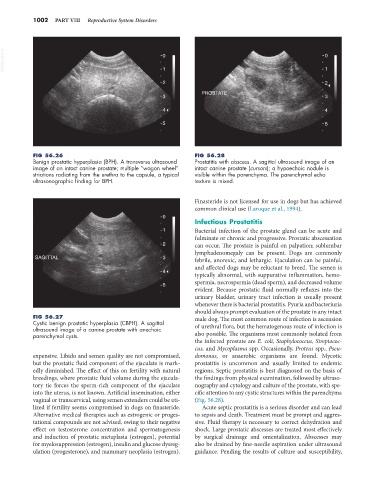Page 1030 - Small Animal Internal Medicine, 6th Edition
P. 1030
1002 PART VIII Reproductive System Disorders
VetBooks.ir 0 1 0
1
2 2
PROSTATE
3 3
4 4
5 5
FIG 56.26 FIG 56.28
Benign prostatic hyperplasia (BPH). A transverse ultrasound Prostatitis with abscess. A sagittal ultrasound image of an
image of an intact canine prostate; multiple “wagon wheel” intact canine prostate (cursors); a hypoechoic nodule is
striations radiating from the urethra to the capsule, a typical visible within the parenchyma. The parenchymal echo
ultrasonographic finding for BPH. texture is mixed.
Finasteride is not licensed for use in dogs but has achieved
common clinical use (Laroque et al., 1994).
0
Infectious Prostatitis
1 Bacterial infection of the prostate gland can be acute and
fulminate or chronic and progressive. Prostatic abscessation
2 can occur. The prostate is painful on palpation; sublumbar
lymphadenomegaly can be present. Dogs are commonly
SAGITTAL 3 febrile, anorexic, and lethargic. Ejaculation can be painful,
and affected dogs may be reluctant to breed. The semen is
4
typically abnormal, with suppurative inflammation, hemo-
spermia, necrospermia (dead sperm), and decreased volume
5
evident. Because prostatic fluid normally refluxes into the
urinary bladder, urinary tract infection is usually present
whenever there is bacterial prostatitis. Pyuria and bacteriuria
should always prompt evaluation of the prostate in any intact
FIG 56.27 male dog. The most common route of infection is ascension
Cystic benign prostatic hyperplasia (CBPH). A sagittal
ultrasound image of a canine prostate with anechoic of urethral flora, but the hematogenous route of infection is
parenchymal cysts. also possible. The organisms most commonly isolated from
the infected prostate are E. coli, Staphylococcus, Streptococ-
cus, and Mycoplasma spp. Occasionally, Proteus spp., Pseu-
expensive. Libido and semen quality are not compromised, domonas, or anaerobic organisms are found. Mycotic
but the prostatic fluid component of the ejaculate is mark- prostatitis is uncommon and usually limited to endemic
edly diminished. The effect of this on fertility with natural regions. Septic prostatitis is best diagnosed on the basis of
breedings, where prostatic fluid volume during the ejacula- the findings from physical examination, followed by ultraso-
tory tie forces the sperm-rich component of the ejaculate nography and cytology and culture of the prostate, with spe-
into the uterus, is not known. Artificial insemination, either cific attention to any cystic structures within the parenchyma
vaginal or transcervical, using semen extenders could be uti- (Fig. 56.28).
lized if fertility seems compromised in dogs on finasteride. Acute septic prostatitis is a serious disorder and can lead
Alternative medical therapies such as estrogenic or proges- to sepsis and death. Treatment must be prompt and aggres-
tational compounds are not advised, owing to their negative sive. Fluid therapy is necessary to correct dehydration and
effect on testosterone concentration and spermatogenesis shock. Large prostatic abscesses are treated most effectively
and induction of prostatic metaplasia (estrogen), potential by surgical drainage and omentalization. Abscesses may
for myelosuppression (estrogen), insulin and glucose dysreg- also be drained by fine-needle aspiration under ultrasound
ulation (progesterone), and mammary neoplasia (estrogen). guidance. Pending the results of culture and susceptibility,

